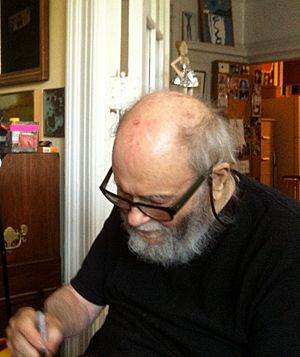Arthur Danto facts for kids
Quick facts for kids
Arthur Coleman Danto
|
|
|---|---|

Arthur Danto, 2012
|
|
| Born | January 1, 1924 |
| Died | October 25, 2013 (aged 89) |
| Alma mater | Wayne State University Columbia University |
| Era | 20th-century philosophy |
| Region | Western philosophy |
| School | Analytic |
|
Main interests
|
Philosophy of art Philosophy of history Philosophy of action |
|
Notable ideas
|
Narrative sentences Basic actions End of Art Post-historical Art Indiscernibles |
|
Influenced
|
|
Arthur Coleman Danto (born January 1, 1924 – died October 25, 2013) was an American art critic, philosopher, and professor at Columbia University. He was well-known for writing about art for The Nation magazine. He also made important contributions to the philosophy of art and the philosophy of history. Danto was interested in how we think and feel, how things are represented, and the ideas of famous philosophers like Hegel, Friedrich Nietzsche, and Jean-Paul Sartre.
Contents
Life and Career of Arthur Danto
Arthur Danto was born in Ann Arbor, Michigan, on January 1, 1924. He grew up in Detroit. After serving two years in the Army, Danto studied art and history at Wayne University, which is now called Wayne State University.
When he was in college, Danto wanted to be an artist. He started creating prints in a style called Expressionism in 1947. Later, he went on to study philosophy at Columbia University. From 1949 to 1950, Danto studied in Paris with a special scholarship. In 1951, he returned to teach at Columbia University.
In 1992, he became a special professor called Johnsonian Professor Emeritus of Philosophy. He also received awards from the Guggenheim Foundation twice. He was a member of the American Academy of Arts and Sciences. Arthur Danto passed away on October 25, 2013, in New York City, at the age of 89.
Arthur Danto's Ideas on Philosophy and Art
Arthur Danto believed that philosophy helps us understand things that might seem one way but are actually another. He thought that science deals with things we can see and test. But philosophy looks at deeper differences that are not always obvious.
Danto also thought that people understand the world by creating "representations" of it in their minds.
The "Artworld" and What Defines Art
Danto helped create a new way to define art. This idea was important because art in the 20th century was changing a lot. People often argue about "What is Art?" Danto's idea is that art is defined by the "artworld."
The "artworld" includes art schools, museums, and artists themselves. They decide what counts as art. This means that art isn't just about how something looks or feels. It's also about its place in the art community. Danto wrote about this in his book Transfiguration of the Commonplace.
Danto said, "A work of art is a meaning given embodiment." This means that art is a way for an idea or meaning to take a physical form. He also said that when we criticize art, we are often looking at how that meaning is shown.
His famous essay, "The Artworld," came out in 1964. In it, he used the term "artworld" to mean the cultural setting or the ideas behind art. This essay greatly influenced how people thought about art. Another philosopher, George Dickie, used Danto's ideas to create his "institutional theory of art." Dickie said that an artwork is something that the artworld decides can be appreciated as art.
Later, Danto simplified his definition of art. He said that art must have a meaning or content. And it must show that meaning in a suitable way.
The "End of Art" Idea
The meaning of "art" has changed many times throughout history. Danto believed that a certain part of art history had come to an end. He didn't mean that people stopped making art. He also didn't mean that good art was no longer being made.
Instead, Danto meant that art no longer had to follow old rules, like trying to perfectly copy reality (called imitation theory). Art could now serve new purposes. He saw art history as moving through different stages. First, art was mainly about imitation. Then, different art styles competed with each other.
Finally, Danto believed we reached a "post-historical era." In this time, there are no strict rules about what art has to be. Anything can be art, and there are no limits on style or ideas. Danto saw this as the final stage in the story of art.
See also
 In Spanish: Arthur C. Danto para niños
In Spanish: Arthur C. Danto para niños

